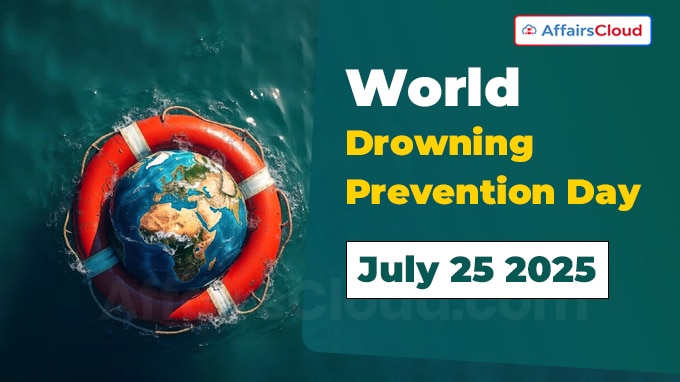 The United Nations (UN)’s World Drowning Prevention Day is annually observed across the globe on July 25 to highlight drowning’s global impact, promote life-saving prevention measures, and catalyse global action for water safety.
The United Nations (UN)’s World Drowning Prevention Day is annually observed across the globe on July 25 to highlight drowning’s global impact, promote life-saving prevention measures, and catalyse global action for water safety.
- July 25, 2025, marks the 5th observance of World Drowning Prevention Day.
Theme:
The 2025 theme for World Drowning Prevention Day is “Your Story Can Save a Life.”
- The theme highlights the importance of personal stories, encouraging survivors and those affected by water-related tragedies to share their experiences to help others learn, take action, and support those dealing with fear or loss.
Background:
UNGA Resolution: On 28th April 2021, the United Nations General Assembly (UNGA) adopted the resolution A/RES/75/273 on global drowning prevention, officially declaring 25th July every year as World Drowning Prevention Day.
1st Observance:World Drowning Prevention Day was marked for the first time on 25 July 2021.
Global Collaboration: The 76th World Health Assembly (May 2023) adopted the first resolution on drowning prevention, titled “Accelerating Action on Global Drowning Prevention”.
- This resolution, proposed by the governments of Bangladesh and Ireland and co-sponsored by at least 72 Member States, requests governments and partners to escalate action through 2029.
Critical Global Statistics on Drowning:
Global Burden: Around 2,36,000 people die from drowning every year across the globe, which means an average of 650 deaths per day or 26 deaths per hour.
- Drowning ranks among the top 10 causes of death for individuals aged 1–24 years.
- It is the 3rd leading cause of unintentional injury-related deaths, accounting for 7% of all injury-related mortality worldwide.
Regional Disparities:
- Low- and middle-income countries (LMICs): Suffer >90% of drowning deaths, often in rivers, lakes, wells, or domestic water storage vessels.
- Western Pacific Region (WPR): Bears 30% of global drowning deaths, with an estimated 84,000 deaths annually. Drowning is the leading cause of death for children aged 5–14 years in this region.
- Eastern Mediterranean: Second-highest drowning rate globally, with the highest fatality rate among children under 4 years of age.
Vulnerable Groups:
- Children: Aged 5–14 years are disproportionately affected by drowning, with boys facing twice the risk compared to girls.
- Migrants and Rural Communities: Have greater exposure to unsafe water environments and often lack access to basic water safety measures or infrastructure
Strategies Recommended by WHO:
WHO advocates four core strategies and six evidence-based, low-cost interventions to drastically reduce drowning fatalities:
Four Strategies:
- Develop a national water safety plan.
- Promote multisectoral collaboration.
- Advance drowning prevention through data collection and research.
- Strengthen public awareness via strategic communications.
Six Key Interventions:
- Safety Measures: Barrier installation to restrict access to hazardous water bodies.
- Safe childcare: Creating safe spaces away from water for preschool-aged children under capable supervision.
- Swimming and rescue training: Basic water safety, swimming skills, and safe rescue techniques.
- Bystander response training: Instruction in safe rescue and resuscitation.
- Boating regulations and enforcement: Safe boating, shipping, and ferry rules.
- Flood resilience and hazard management: Preparedness and mitigation measures.
Progress and Challenges:
Encouraging Trends: Global drowning deaths have declined since 2000, yet >300,000 lives are still lost yearly.
Urgent Gaps: The Western Pacific’s drowning rate is 27–32 times higher than in high-income countries like the United Kingdom or Germany.
About the World Health Organisation (WHO):
Director General (DG) – Dr Tedros Adhanom Ghebreyesus
Headquarters – Geneva, Switzerland
Established – 7 April 1948




